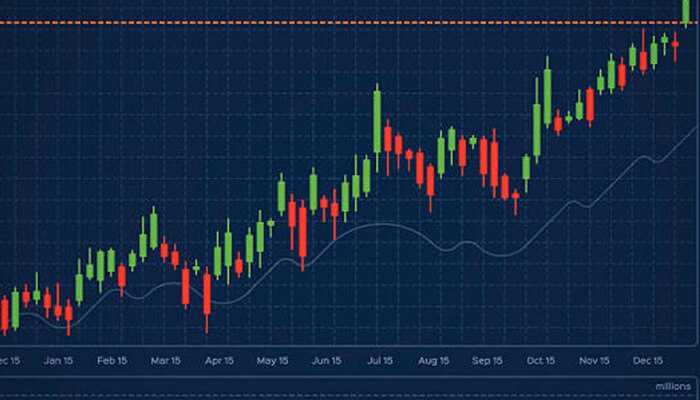Candlestick patterns are one of the most powerful tools traders use to analyse price movements and predict market trends. They offer valuable insights into the emotions of buyers and sellers, helping traders make informed decisions. Whether you are an intraday trader, swing trader, or long-term investor, understanding candlestick patterns can enhance your trading strategies and improve accuracy.
Combining candlestick patterns with technical indicators can further refine trading signals, allowing traders to confirm trends, reversals, and potential breakouts. This article explains the importance of candlestick patterns, different types of patterns, and simple strategies to use them effectively in market analysis.
What are candlestick patterns?
Candlestick patterns are visual representations of price movements in a specific time frame. Each candlestick consists of four main components:
- Open price – The price at which the stock started trading in that time frame.
- Close price – The price at which the stock ended trading in that time frame.
- High price – The highest price reached during that time frame.
- Low price – The lowest price reached during that time frame.
A candlestick has two parts: the body (which represents the open and close prices) and the wick or shadow (which represents the high and low prices).
Why are candlestick patterns important in trading?
Candlestick patterns provide traders with important market signals, helping them:
- Identify trend reversals or continuations.
- Determine market sentiment (bullish or bearish).
- Improve entry and exit points for trades.
- Combine with technical indicators for better trade confirmation.
Types of candlestick patterns
Candlestick patterns are broadly classified into bullish, bearish, and neutral patterns.
1. Bullish candlestick patterns
Bullish patterns indicate a potential upward price movement, signalling traders to consider buying opportunities.
Hammer
- A single candlestick with a small body and a long lower wick.
- Appears at the end of a downtrend, indicating a possible reversal.
Bullish engulfing
- A two-candle pattern where a smaller red candle is followed by a larger green candle that completely engulfs it.
- Indicates strong buying momentum and a potential upward move.
Morning star
- A three-candle pattern appearing at the end of a downtrend.
- Consists of a long red candle, a small indecisive candle, and a long green candle.
- Suggests a reversal from bearish to bullish.
2. Bearish candlestick patterns
Bearish patterns indicate a potential downward price movement, signalling traders to consider selling opportunities.
Shooting star
- A single candlestick with a small body and a long upper wick.
- Appears at the end of an uptrend, suggesting a reversal.
Bearish engulfing
- A two-candle pattern where a smaller green candle is followed by a larger red candle that completely engulfs it.
- Indicates strong selling pressure and a potential downward move.
Evening star
- A three-candle pattern appearing at the end of an uptrend.
- Consists of a long green candle, a small indecisive candle, and a long red candle.
- Suggests a reversal from bullish to bearish.
3. Neutral candlestick patterns
Neutral patterns indicate indecision in the market and do not strongly suggest a trend continuation or reversal.
Doji
- A small-bodied candle where the open and close prices are almost equal.
- Indicates market indecision and is often a sign of a potential reversal.
Spinning top
- A small-bodied candle with long upper and lower wicks.
- Suggests uncertainty and a balance between buyers and sellers.
How to use candlestick patterns with technical indicators
While candlestick patterns are useful on their own, combining them with technical indicators can strengthen trade signals.
1. Moving averages
Moving averages help traders confirm trends and identify potential reversals.
- A bullish engulfing pattern forming above a 50-day moving average indicates a strong uptrend.
- A bearish engulfing pattern below the moving average suggests a downtrend.
2. Relative strength index (RSI)
RSI measures market momentum and overbought or oversold conditions.
- A hammer pattern appearing in an oversold region (RSI below 30) suggests a potential buying opportunity.
- A shooting star in an overbought region (RSI above 70) signals a potential sell-off.
3. Bollinger bands
Bollinger bands help traders identify volatility and price breakouts.
- A morning star pattern forming near the lower Bollinger band suggests a bullish reversal.
- A bearish engulfing pattern near the upper Bollinger band indicates potential downward pressure.
4. Volume analysis
Volume plays a crucial role in confirming candlestick patterns.
- A bullish engulfing pattern with high trading volume strengthens the likelihood of a trend reversal.
- A doji pattern with low volume suggests weak market conviction.
Simple trading strategies using candlestick patterns
Traders can use candlestick patterns in various ways to improve their trading strategies.
1. Reversal strategy
- Identify key support or resistance levels.
- Look for reversal patterns like hammer, morning star, or shooting star.
- Confirm the pattern using RSI or moving averages before entering the trade.
2. Trend-following strategy
- Use moving averages to determine the trend direction.
- Enter long trades when bullish patterns like bullish engulfing appear in an uptrend.
- Enter short trades when bearish patterns like bearish engulfing appear in a downtrend.
3. Breakout strategy
- Identify a consolidation phase where the price moves sideways.
- Look for breakout candlestick patterns like bullish or bearish engulfing.
- Confirm the breakout with high volume before entering the trade.
4. Stop-loss and risk management
- Always place stop-loss orders below the pattern’s low for bullish trades.
- Place stop-loss orders above the pattern’s high for bearish trades.
- Maintain a risk-to-reward ratio of at least 1:2 for better capital protection.
Common mistakes to avoid when using candlestick patterns
- Relying on these alone without using technical indicators for confirmation.
- Ignoring market conditions and trading candlestick patterns in a low-liquidity environment.
- Not setting stop-loss orders, leading to unexpected losses.
- Overtrading based on every candlestick pattern without considering broader market trends.
Conclusion
Mastering candlestick patterns is an essential skill for traders looking to improve their decision-making and market timing. These patterns provide valuable insights into price movements and investor sentiment, helping traders spot opportunities and manage risks effectively.
Combining these with technical indicators such as moving averages, RSI, and volume analysis enhances trade accuracy and reduces false signals. By following simple strategies and avoiding common mistakes, traders can use these to develop a structured and disciplined approach to market trading. Whether trading stocks, forex, or commodities, learning this can help traders make smarter investment decisions.



